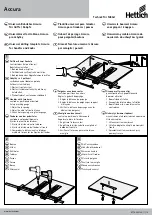
16
SYSTEM
soil surrounding the sensors (
b
). A considerable amount of research has been conducted to
determine the relationship between
b
and
p
. Hilhorst (2000) took advantage of the linear
relationship between the soil bulk dielectric permittivity (
b
) and
b
to accurately convert
b
to
p
if the
b
is known. The TEROS 12 sensor measures
b
and
b
nearly simultaneously in the
same soil volume. Therefore, the TEROS 12 is well suited to this method.
The pore water conductivity (
p
) is determined from
(see Hilhorst 2000 for derivation):
Equation 1
σ
p
=
ε
p
σ
b
ε
b
−ε
σ
b
=
0
where
p
is the pore water EC (dS/m),
p
is the real portion of the dielectric permittivity of the soil pore water (unitless),
b
is the bulk EC (dS/m) measured directly by the TEROS 11/12,
b
is the real portion of the dielectric permittivity of the bulk soil (unitless), and
b = 0
is the real portion of the dielectric permittivity of the soil when bulk EC is 0 (unitless).
Dielectric permittivity of the soil pore water (
p
) is calculated from soil temperature using
Equation 2
:
Equation 2
ε
p
=
80
.
3
−
0
.
37
×
T
soil
−
20
(
)
where
T
soil
is the soil temperature (
°
C) measured by the TEROS 12.
Finally,
b = 0
is an offset term loosely representing the dielectric permittivity of the dry
soil. Hilhorst (2000) recommended that
b = 0
= 4.1 be used as a generic offset. Hilhorst
(2000) offers a simple and easy method for determining
b = 0
for individual soil types, which
improves the accuracy of the calculation of
p
in most cases.
METER testing indicates that the method for calculating
p
(
Equation 1
) results in
good accuracy (±20%) in moist soils and other growth media. In dry soils, where VWC
is less than 0.10 m
3
/m
3
, the denominator of
Equation 1
becomes very small, leading
to large potential errors. METER recommends that
p
not be calculated in soils with
VWC < 0.10 m
3
/m
3
using this method.
3.3.5 PORE WATER VERSUS SATURATION EXTRACT EC (TEROS 12 ONLY)
As noted in
, pore water EC can be calculated from bulk EC using the sensor-
measured dielectric permittivity of the medium. However, pore water EC is not the same as
saturation extract EC.
Pore water EC is the EC of the water in the pore space of the soil. This could be measured
directly if the soil was squeezed under high pressure to force water out of the soil matrix and
that water was collected and tested for EC.











































